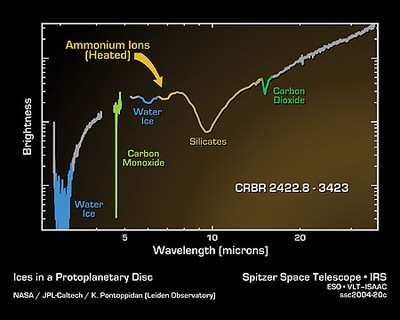NASA's Spitzer Space Telescope Helps Astronomers Better
Understand How Stars Form
 Two discoveries -- the detection of
an oddly dim object inside what was thought to be an empty cloud,
and the discovery of icy planetary building blocks in a system
believed to resemble our own solar system in its infancy -- were
presented this week at the first Spitzer science conference in
Pasadena (CA). Since Spitzer science observations began less than
one year ago, the infrared capabilities of the space observatory
have unveiled hundreds of space objects too dim, cool or distant to
be seen with other telescopes.
Two discoveries -- the detection of
an oddly dim object inside what was thought to be an empty cloud,
and the discovery of icy planetary building blocks in a system
believed to resemble our own solar system in its infancy -- were
presented this week at the first Spitzer science conference in
Pasadena (CA). Since Spitzer science observations began less than
one year ago, the infrared capabilities of the space observatory
have unveiled hundreds of space objects too dim, cool or distant to
be seen with other telescopes.
In one discovery, astronomers have detected a faint, star-like
object in the least expected of places -- a "starless core." Named
for their apparent lack of stars, starless cores are dense knots of
gas and dust that should eventually form individual newborn stars.
Using Spitzer's infrared eyes, a team of astronomers led by Dr.
Neal Evans of the University of Texas at Austin probed dozens of
these dusty cores to gain insight into conditions that are needed
for stars to form.
Starless cores are fascinating to study because they tell us what
conditions exist in the instants before a star forms. Understanding
this environment is key to improving our theories of star
formation, said Evans.

But when they looked into one core, called L1014, they found a
surprise -- a warm glow coming from a star-like object. The object
defies all models of star formation; it is fainter than would be
expected for a young star. Astronomers theorize that the mystery
object is one of three possibilities: the youngest "failed star,"
or brown dwarf ever detected; a newborn star caught in a very early
stage of development; or something else entirely.
This object might represent a different way of forming stars or
brown dwarfs. Objects like this are so dim that previous studies
would have missed them. It might be like a stealth version of star
formation, Evans said. The new object is located 600 light-years
away in the constellation Cygnus.
In another discovery, Spitzer's infrared eyes have peered into the
place where planets are born -- the center of a dusty disc
surrounding an infant star -- and spied the icy ingredients of
planets and comets. This is the first definitive detection of ices
in planet-forming discs.
This disc resembles closely how we imagine our own solar system
looked when it was only a few hundred thousand years old. It has
the right size, and the central star is small and probably stable
enough to support a water-rich planetary system for billions of
years into the future, said Dr. Klaus Pontoppidan of Leiden
Observatory in the Netherlands, who led the team that made this
discovery.

Previously, astronomers had seen ices, or ice-coated dust
particles, in the large cocoons of gas and dust that envelop young
stars. But they were not able to distinguish these ices from those
in the inner planet-forming portion of a star's disc. Using
Spitzer's ultra-sensitive infrared vision and a clever trick,
Pontoppidan and his colleagues were able to overcome this
challenge.
Their trick was to view a young star and its dusty disc at "dawn."
Discs can be viewed from a variety of angles, ranging from the side
or edge-on, where the discs appear as dark bars, to face-on, where
the discs become washed out by the light of the central star. They
found that if they observed a disc at a 20-degree angle, at a
position where the star peeks out like our Sun at dawn, they could
see the ices.
"We hit the sweet spot," said Pontoppidan. "Our models predicted
that the search for ices in discs is a problem of finding an object
with just the right viewing angle, and Spitzer confirmed that
model.

In this system, astronomers found ammonium ions as well as
components of water and carbon dioxide ice.
The Spitzer science conference, "The Spitzer Space Telescope: New
Views of the Cosmos," is being held at the Sheraton Pasadena
hotel.
 Aero-News: Quote of the Day (12.07.25)
Aero-News: Quote of the Day (12.07.25) ANN's Daily Aero-Linx (12.07.25)
ANN's Daily Aero-Linx (12.07.25) NTSB Final Report: Lafferty Jack Sea Rey
NTSB Final Report: Lafferty Jack Sea Rey Classic Aero-TV: The B29 SuperFortress Doc - History in Flight
Classic Aero-TV: The B29 SuperFortress Doc - History in Flight Airborne 12.08.25: Samaritans Purse Hijack, FAA Med Relief, China Rocket Fail
Airborne 12.08.25: Samaritans Purse Hijack, FAA Med Relief, China Rocket Fail






